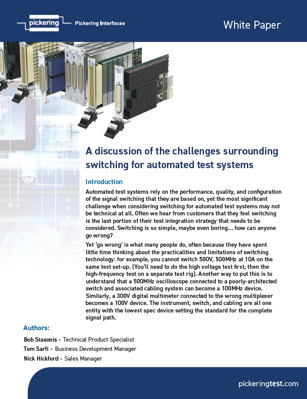Automated test systems rely on the performance, quality, and configuration of the signal switching that they are based on, yet the most significant challenge when considering switching for automated test systems may not be technical at all. Often we hear from customers that they feel switching is the last portion of their test integration strategy that needs to be considered. Switching is so simple, maybe even boring… how can anyone go wrong?
Think about the questions you should ask yourself surrounding switching for automated test systems such as:
- What is a the importance of high-quality switching?
- What are the differences between reed relays, electromechanical relays and solid-state relays?
- What types of switching configurations are available?
- Which cables, connectors and mass interconnect products should be included with my switch module?
The switching system is intrinsic to the success of the test process, so it’s important to understand the possibilities and limitations. However dull switching may seem, there are very many challenges to be considered, but the information is all here to help you.
To learn more on this subject, check out our white paper, "The challenges surrounding switching for automated test systems."
